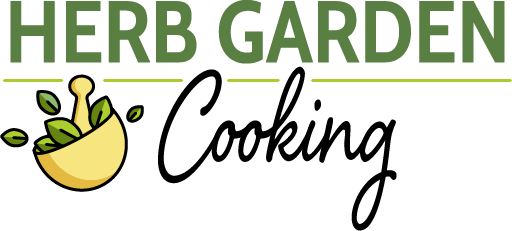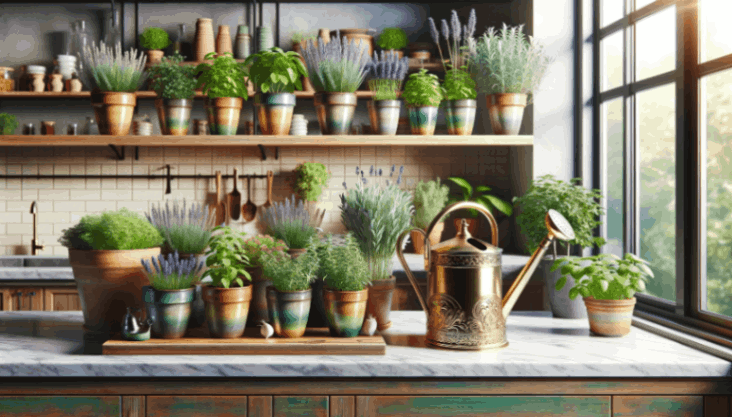This post may contain affiliate links which means I may receive a commission for purchases made through links. I only recommend products that I have personally used. As an Amazon Associate I earn from qualifying purchases. Learn more on my Private Policy page.
Proper watering is crucial for the health and vitality of your indoor herb garden. Whether you’re a seasoned herb gardener or just starting out, understanding how to water your indoor herbs correctly is essential.
To water indoor herbs, check the moisture of the top inch of soil. If it’s dry, it’s generally time to water. Different herbs have specific needs, as some herbs prefer drier conditions than others. Avoid common mistakes like overwatering, which leads to root rot. It’s better to water deeply and less frequently.
Keep reading for guidelines on how often to water specific herbs, learn what mistakes to avoid when watering indoor herbs, and for troubleshooting tips when watering herb gardening.
Table of Contents
How Often to Water Indoor Herbs
For a thriving indoor garden, it’s important to know how to water indoor herbs, including the frequency and specific moisture needs of individual herbs. Each herb’s unique requirements determine its ideal watering schedule.
| Herb | Watering Frequency After Transplanting |
|---|---|
| Basil | Every 3-4 days, keep soil slightly moist |
| Cilantro | Every 3-4 days, keep soil consistently moist but not waterlogged |
| Dill | Every 3-4 days, depending on humidity. Keep soil slightly moist |
| Mint | Every 2-3 days, prefers consistently moist soil |
| Oregano | Every week, allow soil to dry out slightly between watering |
| Parsley | Every 3-4 days, keep soil slightly moist |
| Rosemary | Every 1-2 weeks, allow soil to dry out completely between watering |
| Sage | Every 1-2 weeks, let the soil dry completely between waterings |
| Thyme | Every week to 10 days, prefers slightly dry conditions. |

Basil
Basil thrives in soil that is evenly moist but not waterlogged. Overwatering can lead to root rot, so be cautious not to saturate the soil excessively. Water basil plants deeply. Give them a thorough watering, allowing the excess water to drain out. Aim to water your basil plants every 3 or 4 days.

Cilantro
Cilantro must typically be watered every 3 to 4 days when grown indoors. Cilantro is sensitive to both underwatering and overwatering. Signs that cilantro is not receiving enough or excess moisture include wilting leaves or yellowing foliage.

Dill
Dill, when cultivated indoors, prefers a consistent moisture level in its soil. It generally requires watering every 3 to 4 days, with the frequency depending on the humidity levels of your indoor environment. Dill prefers soil that is slightly moist but not soggy, as it does not fare well in overly wet conditions. Regularly monitoring the soil’s moisture will help maintain optimal growth conditions for indoor dill plants.

Mint
Mint has higher water requirements than many other herbs due to its fast growth rate and shallow roots. Keep mint consistently moist, but avoid overwatering as it can lead to root rot. Monitor moisture levels closely and provide enough water when the top inch of soil feels slightly dry. When grown indoors, mint should be lightly watered every 2 to 3 days.

Oregano
Oregano prefers moderate moisture levels and well-drained soil. Watering oregano once per week should be sufficient to meet its moisture requirements. Allow the top inch of soil to dry out before watering again. Signs that oregano requires more or less water than usual include wilting leaves or yellowing foliage. Avoid overwatering by ensuring proper drainage and providing enough airflow around the plant.

Parsley
Parsley grown indoors needs consistent but moderate watering. It’s best to water parsley every 3-4 days, allowing the top inch of the soil to dry out before the next watering. Overwatering should be avoided, as parsley does not like to sit in waterlogged soil, but it shouldn’t be allowed to dry out completely. This balance ensures healthy growth and vibrant leaves.

Rosemary
Rosemary prefers slightly drier conditions compared to other herbs. Allow the top 2 inches of soil to dry out between watering sessions. Ensure proper drainage by using well-draining soil and pots with drainage holes to prevent root rot. Rosemary only needs to be watered once every 1 to 2 weeks.

Sage
Sage prefers drier conditions than many other herbs, making it more tolerant of drought. It’s best to water sage every 1 to 2 weeks, allowing the top few inches of soil to dry out between watering sessions. Signs that sage is being overwatered or underwatered include yellowing leaves or drooping foliage. Water sage infrequently, but give it a thorough watering to promote healthy growth.

Thyme
When grown indoors, thyme requires minimal watering compared to many other herbs. Thyme thrives when the soil is allowed to dry out completely between waterings, typically needing water only every week to 10 days. This herb prefers slightly dry conditions, making it important to avoid overwatering to prevent root rot and maintain its health.
Common Mistakes to Avoid When Watering Indoor Herbs
To ensure healthy growth for your indoor herbs, it’s crucial to avoid common watering mistakes that can harm their overall well-being:
- Overwatering: One of the most common mistakes is overwatering plants. Too much water can lead to root rot or fungal diseases due to excessive moisture around the roots.
- Underwatering: On the other hand, underwatering can cause wilting and stunted growth. It’s important not to let your herb pots completely dry out between waterings.
- Incorrect watering frequency: Each herb has its own specific watering needs, so it’s essential to research and understand the requirements of the herbs you are growing. Some herbs prefer slightly drier conditions, while others need more frequent watering.
- Inadequate drainage: Proper drainage is crucial to prevent waterlogging in herb pots. Ensure your pots have drainage holes, and use well-draining soil to avoid water accumulation.
- Watering from above: Avoid watering your herbs from above as this can lead to wet foliage, which increases the risk of fungal diseases. Instead, water at the base of the plant directly onto the soil.
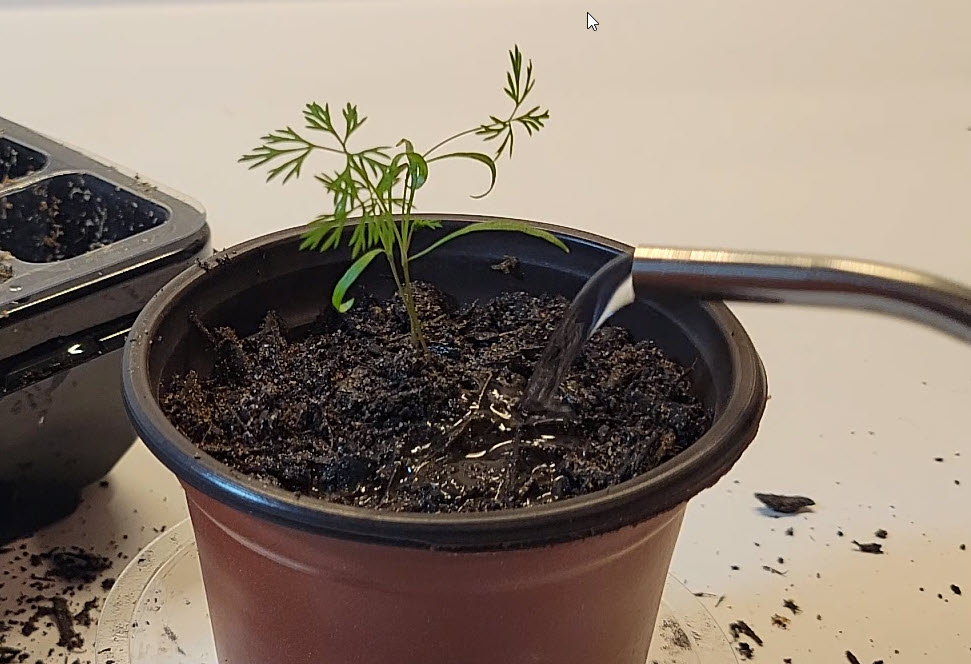
Remember that it’s always better to underwater than overwater your indoor herbs. When I first started growing herbs indoors, I watered them all the time. Not good! I was always thinking they needed far more water than they did. Falling into the overwatering trap as a beginning gardener is very easy to do. Please don’t make the same mistakes I made when I first began growing indoor herbs.
Before watering, check the moisture level of the soil by sticking your finger about an inch deep into the soil. If it feels dry at that depth, it’s time to water.
Establishing a Watering Routine for Indoor Herbs
Maintaining a proper watering routine ensures that your herbs receive the right amount of moisture, promoting healthy growth and preventing issues such as root rot or dehydration.
Importance of Consistency in Watering Indoor Herbs
Consistent watering is important for indoor herbs to stay healthy and grow well. Irregular watering can lead to plant stress, causing fluctuations in soil moisture levels possibly negatively impacting their development.
To maintain consistency, it’s essential to water your herbs at regular intervals. This could be once a week or every few days, depending on the specific needs of each herb species and environmental conditions.
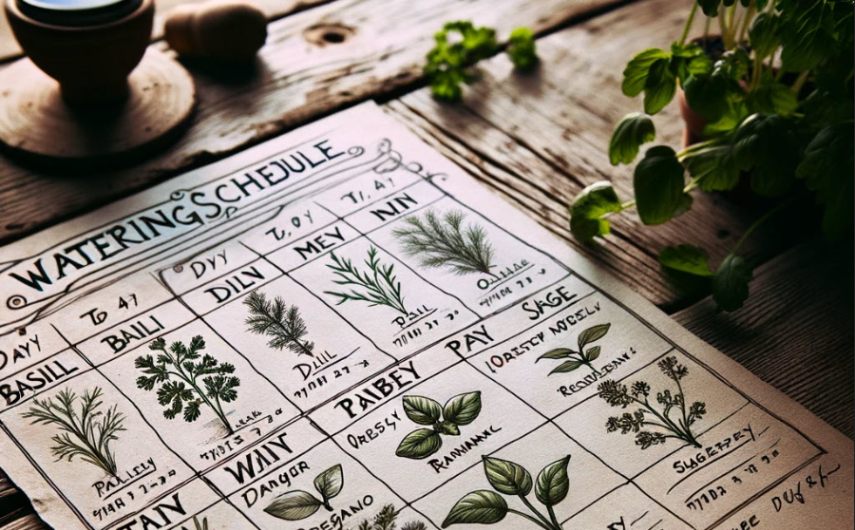
Factors to Consider When Creating a Watering Schedule
Several factors should be taken into account when establishing a watering schedule for your indoor herbs:
- Herb Species: Different herbs have different water needs. Some herbs, like basil or parsley, like moist soil, while others, like rosemary or thyme, prefer drier conditions. Refer to the table above for watering frequency guidelines for individual herbs.
- Environmental Conditions: Environmental factors such as temperature, humidity levels, and air circulation can affect how quickly the soil dries out. For instance, if you live in a hot and dry climate, you may need to water more frequently compared to someone living in a cooler and more humid environment.
- Potting Mix: The type of potting mix used also plays a role in determining how often you should water your indoor herbs. Well-draining soil mixes allow excess water to escape easily and prevent waterlogging, while heavier mixes retain moisture for longer periods.
- Pot Size: The size of the pot affects how much water the soil can hold. Larger pots generally retain more moisture, reducing the watering frequency, while smaller pots dry out more quickly and may require more frequent watering.
Tips for Watering Herbs in Pots
Let’s dive into a few practical tips for indoor herb watering. Understanding the nuances of pot size, soil type, and watering techniques is key to ensuring your indoor herbs thrive.
Choosing the Right Pot Size and Growing Medium
Choosing a pot that allows room for the herb’s root system to grow is important. A pot that is too small can restrict root growth and lead to waterlogged soil, while a pot that is too large may retain excess moisture, increasing the risk of overwatering.
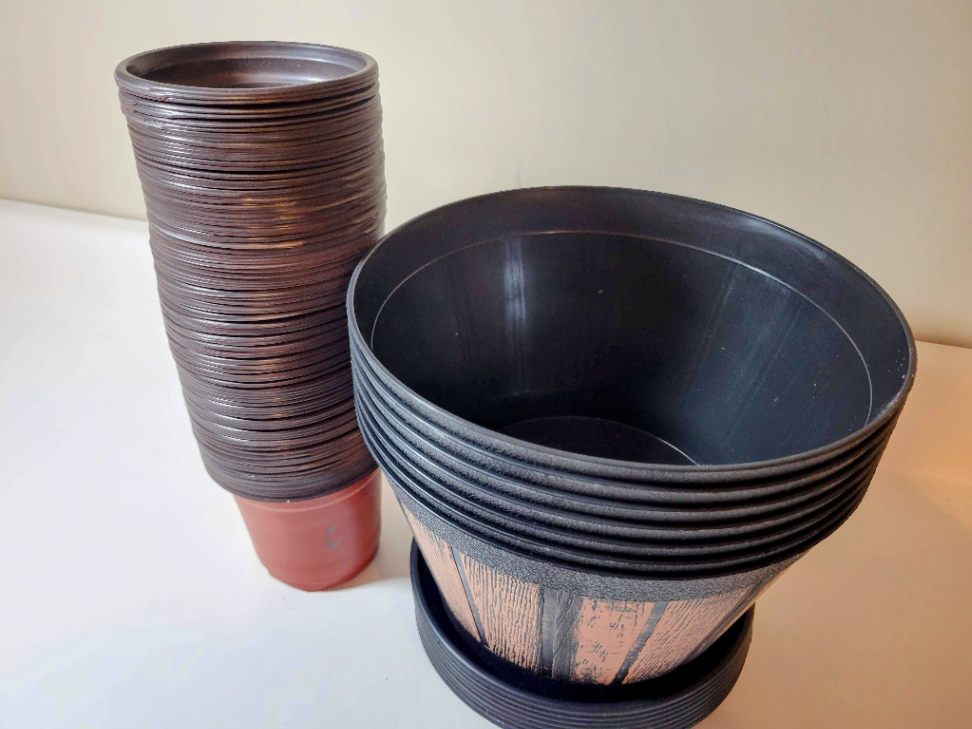
Check out my article on transplanting indoor herbs for additional information about the ideal pot sizes for various indoor herbs.
The type of growing medium significantly impacts the watering frequency for indoor herbs. Well-draining mixes dry out faster and require more frequent watering, while denser, moisture-retaining soils need watering less often. Ingredients like perlite or sand enhance drainage, leading to quicker drying, whereas organic matter like compost can increase water retention.
See my article What is the Best Soil for Indoor Herbs for my recommendations on growing mediums for specific herbs.
Water Indoor Herbs Deeply But Infrequently
When watering your indoor herbs, water them deeply. To ensure proper watering of indoor herbs, it is important to fully saturate the soil until water starts to drain out from the bottom of the pot. It’s best to give your herbs a thorough watering, but allow the soil to dry out slightly before watering again.
To avoid overwatering, always check the soil’s moisture level before watering. Stick your finger about an inch into the soil; if it feels dry at that depth, it’s time to water. If it still feels moist, hold off on watering for a few more days.
Combining Rainwater with Tap Water for Healthier Herbs
Over the years, I discovered an unconventional yet effective watering technique that is particularly well-suited to urban gardeners. I found that using a blend of rainwater and tap water can enhance the growth and health of indoor herbs.
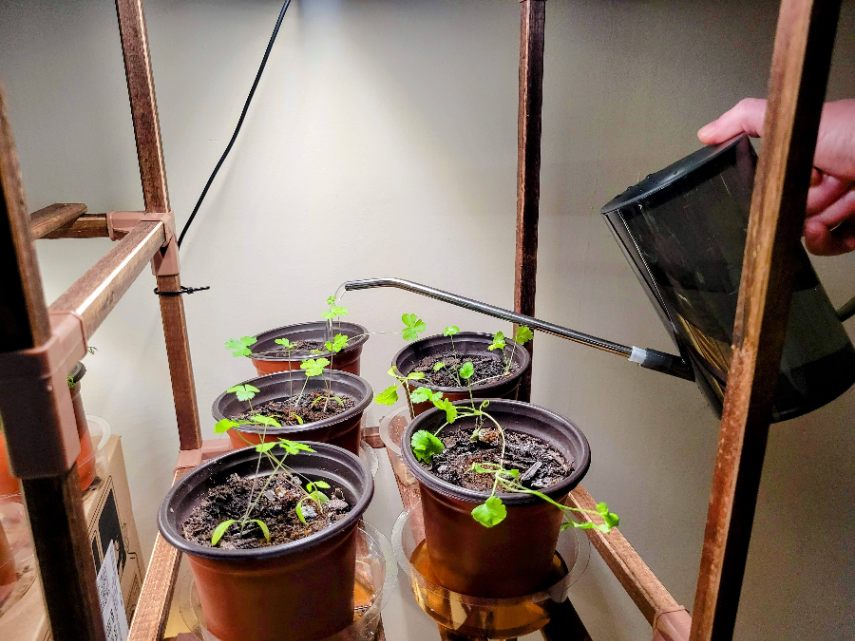
Rainwater, being naturally soft and devoid of chemicals found in tap water, can provide a more natural hydration method for your plants, more closely replicating a more natural ecosystem for indoor herbs. I experimented with this by collecting rainwater in a simple DIY setup on my patio and noticed a marked improvement in the health of my herbs, particularly in those like basil and mint, which seemed to be more sensitive to water quality.
The Art of Misting and Microclimate Management
Another gardening hack I’ve discovered since I started growing herbs indoors is that a ‘one-size-fits-all’ approach to watering doesn’t do justice to the nuanced needs of different herbs. I’ve found that Mediterranean herbs like rosemary and thyme do well when exposed to a regular misting to mimic their native dewy mornings. Incorporating a gentle misting into your watering schedule for these herbs helps to reproduce their natural habitat, encouraging stronger aromatic oils.
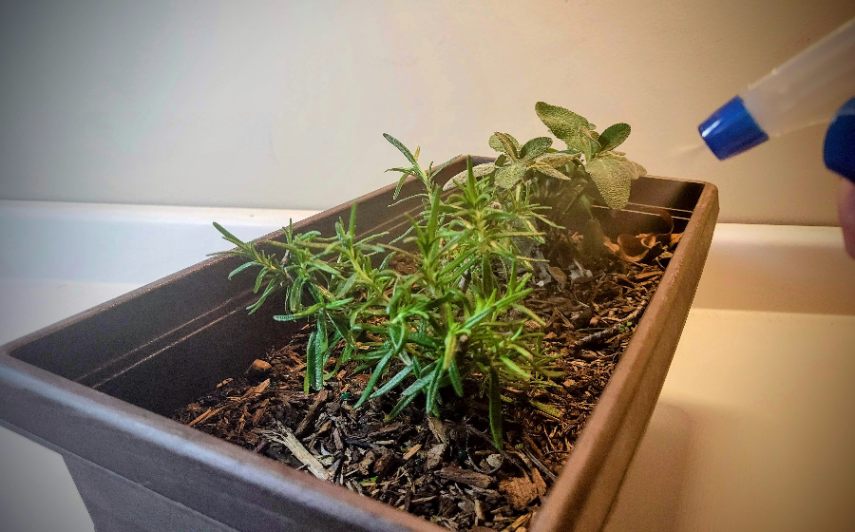
Strategies to Prevent Water Evaporation
Indoor environments can be drier than outdoor ones due to factors like central heating or air conditioning systems.
To prevent excessive water evaporation from potted herbs, particularly in arid environments, consider the following strategies:
- Grouping: Place your herb pots together to create a microclimate with higher humidity levels. This can help reduce moisture loss through evaporation.
- Mulching: Apply a layer of organic mulch, such as straw or wood chips, on top of the soil surface. Mulch helps retain moisture by reducing evaporation and also adds nutrients to the soil as it breaks down.
- Using a Humidity Tray: Set up a humidity tray by placing a shallow dish filled with water near your potted herbs. As the water evaporates, it increases the humidity around the plants.
By implementing these strategies, you can minimize water evaporation and ensure that your indoor herbs receive adequate moisture for healthy growth.
Troubleshooting Common Watering Issues
Signs of Overwatering or Underwatering in Herbs
Identifying whether your indoor herbs are overwatered or underwatered is crucial for their health and growth. To determine if your herbs are receiving the right amount of water, pay close attention to the following signs:
- Wilting: If your herbs appear droopy and lackluster, it could be a sign of either overwatering or underwatering. If the soil feels wet to the touch, even when the plant is wilting, you’re more likely overwatering.
- Yellow Leaves: Yellow leaves can also indicate either overwatering or underwatering. If the leaves turn yellow and feel mushy or slimy, this suggests overwatering and potential root rot. On the other hand, dry and crispy yellow leaves usually point towards underwatering.
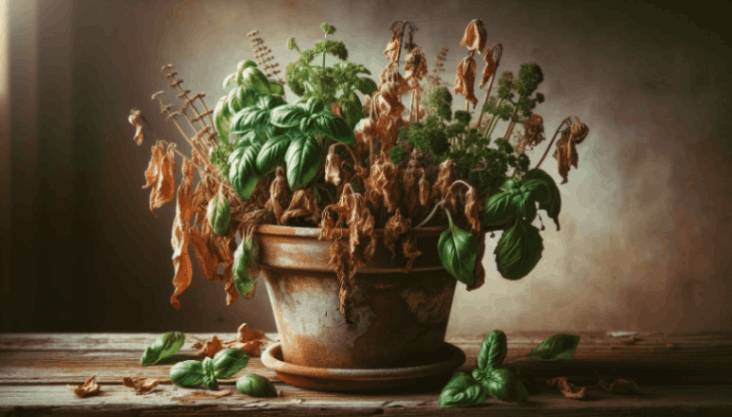
Solutions to Address Root Rot Caused by Excessive Moisture
Root rot is a common issue that arises from excessive moisture in potted plants, including indoor herbs. It occurs when there is inadequate drainage or when plants are consistently exposed to excess water. To address root rot effectively:
- Adjust Your Watering Routine: Ensure you’re not watering your herbs too frequently or giving them excessive amounts of water at once. Instead, aim for consistent watering with thorough but infrequent sessions to promote a healthy root system when growing herbs indoors.
- Improve Drainage: Check if your herb pots have proper drainage holes at the bottom. If not, consider repotting them into containers with adequate drainage to prevent water from pooling around the roots.
By identifying signs of overwatering or underwatering in your indoor potted herbs and implementing appropriate solutions, you can help them thrive and flourish in your home. Remember to observe your herbs’ individual watering needs, provide thorough but infrequent watering sessions, provide adequate drainage, and establish a consistent watering schedule.
Indoor Climate Considerations: How to Water Indoor Herbs Year Round
Watering your indoor herb garden involves adapting to changes brought by indoor heating and air conditioning as the seasons change, which can affect your plants’ moisture needs.
Heating Periods (Autumn and Winter)
When heaters are on during the colder months, they reduce indoor humidity, leading to quicker soil drying. Although this may necessitate more frequent watering, be cautious to avoid overwatering, especially since herbs grow slower in these seasons.
Air Conditioning Periods (Summer)
In summer, air conditioning lowers indoor temperatures and humidity, potentially altering watering frequencies. While it may not dry the soil as quickly as natural heat, you might still need to water your herbs more often than in milder conditions. Monitor soil moisture and adjust accordingly.
Natural Ventilation Periods (Spring and Autumn)
During periods of natural ventilation, indoor conditions are more stable, requiring normal watering routines. Adjust only if external weather significantly affects indoor humidity or temperature.

Conclusion
Understanding the basics of watering indoor herbs is essential for their health and productivity. By identifying the water needs of common herbs and establishing a consistent watering routine, you can ensure that your indoor herb garden thrives. Following tips for watering herbs in pots and troubleshooting any watering issues will help you maintain optimal plant conditions.
To enhance your indoor herb gardening experience further, consider setting up a well-designed space that provides adequate light and ventilation, either on a sunny windowsill in your kitchen or under a grow light. By creating an environment that mimics outdoor conditions, you can maximize the growth and flavor of your herbs. Remember to monitor the moisture levels in the soil regularly and adjust your watering accordingly.
Frequently Asked Questions (FAQs)
How often should I water indoor herbs?
Indoor herbs typically require watering once or twice a week. However, the frequency may vary depending on factors like humidity levels and the type of herb. It’s essential to check the soil moisture before watering to avoid overwatering or underwatering.
What is the best way to water indoor herbs?
The best way to water indoor herbs is by using a watering can with a narrow spout or a spray bottle. Water the soil directly at the base of the plant until it starts dripping from the drainage holes. Avoid getting water on the leaves as it can lead to fungal diseases.
How do you know if herbs need water?
You can check if your indoor herbs need watering by inserting your finger about an inch into the soil. If it feels dry, it’s time to water them. Another method is lifting up the pot; if it feels light, it indicates that the plant needs watering.
Should I use tap water or filtered water for indoor herbs?
Tap water is generally suitable for most indoor herbs unless you live in an area with particularly hard or chlorinated water. If you have concerns about tap water quality, allowing it to sit overnight before use can help dissipate any chlorine present. Alternatively, you can use filtered or distilled water.
Can you overwater potted herbs?
Overwatering is one of the most common mistakes in caring for potted herbs. Overwatering can lead to root rot and other issues due to poor drainage and lack of soil oxygen. It’s crucial to use pots with proper drainage and to water only when the top inch of the soil is dry.
Can I use self-watering pots for growing indoor herbs?
Self-watering pots are a convenient option for growing indoor herbs as they provide consistent moisture without overwatering. Ensure proper drainage in these pots and monitor the moisture level regularly to prevent any issues with root rot or mold growth.
Last Updated on 26 November 2023 by Bob Lee
